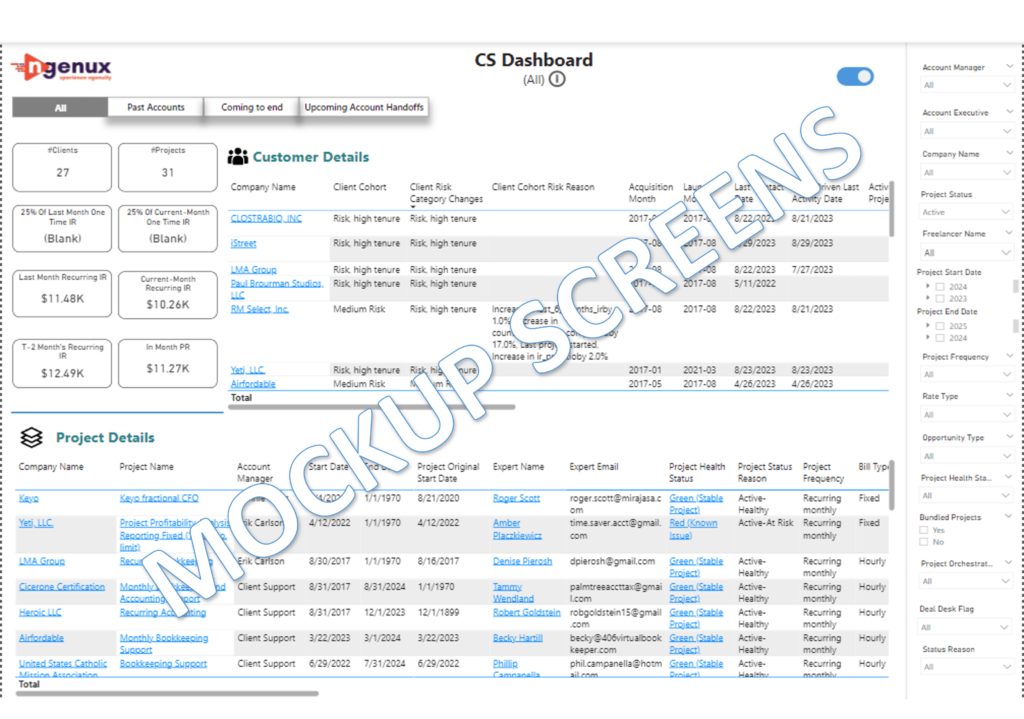The client operates as a marketplace company that bridges pre-vetted finance professionals with businesses seeking their expertise. This platform provides access to a wide range of skilled professionals, including Account Managers, bookkeepers, financial analysts, and CFOs. It offers businesses an efficient way to access specialized financial services from a diverse pool of professionals.
However, despite the myriad benefits these marketplace companies provide, they are not immune to challenges. Successfully managing supply and demand, maintaining top-notch quality control, and instilling trust and safety among users are just a few hurdles they face. One of the most critical elements in addressing these challenges lies in the hands of the customer success team – the powerhouse that nurtures customer relationships and drives business growth.
The customer success team faces several challenges in managing their book of business effectively. Without a dedicated single point source, team struggle to track their progress toward performance metrics and commission-based targets. They also lack a streamlined way to identify potential cross-selling and upselling opportunities, as well as to pinpoint projects or accounts at risk of failing. This results in inefficiencies, manual data handling using spreadsheets, and missed revenue opportunities. In essence, the absence of a single source hampers the Account Managers ability to proactively manage customer success, leading to suboptimal outcomes and increased reliance on time-consuming manual processes.
Solution
A customer success dashboard(CS) empowers the customer success team to proactively manage their book of business. It offers a centralized platform for Account Managers(AM) to track their progress toward performance metrics, including commission-based targets. The dashboard uses AI-driven recommendation models to identify potential cross-selling, upselling opportunities and highlights any projects or accounts that are at risk of failing. With actionable insights and a clear plan for each situation, the dashboard helps AM’s to improve customer success outcomes while reducing their reliance on spreadsheets that needs lot of manual intervention. In a nutshell, customer success dashboard streamlines the account management process and enables account managers to work more efficiently and effectively.
Technology Challenge
One significant challenge for the CS tool described in the business problem statement is the integration of data from multiple sources to provide Account Managers with a comprehensive view of a customers’ status and identify cross-selling and upselling opportunities, sources are very well diversified that includes CRM, project management tools, and financial systems. This integration must be real-time, accurate, and provide up-to-date information for each Account Managers’ book of business.
Another challenge is to design and develop an intuitive interface that enables AM’s to access and use the tool effectively. Tool should be capable of presenting relevant information in a clear and digestible format and allow AM’s to filter and sort data to prioritize their actions efficiently. Additionally, the tool should be customizable to meet each AM’s unique needs and preferences while maintaining consistency across the platform.
Finally, the CS tool must be secure, scalable, and capable of managing large volumes of data while ensuring the privacy and confidentiality of customer information.
Technology/Frameworks used for Implementing the solution
Snowflake: A cloud-based data warehousing platform that provides scalable, secure, reliable storage and capable of processing big chunks of data. With its architecture, Snowflake can integrate data from various sources, including CRM, project management tools, and financial systems, and provide real-time data processing capabilities. Snowflake also provides enterprise-level security features, such as end-to-end encryption, role-based access control, and compliance certifications.
SQL: SQL is used to query the Snowflake data warehouse and retrieve data for the Power BI reports. Snowflake supports standard SQL syntax, so no proprietary query language is required.
Power BI: A business intelligence tool that can connect to Snowflake and provide powerful visualization capabilities, allowing Account Managers to identify trends, visualize patterns, and explore insights. Power BI can also create interactive dashboards and reports that can be customized to meet the specific needs of individual AM, enabling them to monitor and manage their book of business effectively.
Solution Architecture Diagram

Challenges during implementation and how are they tackled
Data Integration: As mentioned, it required data from various sources to be integrated. This could be challenging due to differences in data formats, data quality, and data governance policies. To handle this challenge, data integration solutions such as ETL tools, data validation frameworks, and data cleansing techniques were used to standardize and cleanse the data before it was loaded into Snowflake.
Scalability: As the amount of data increases, Snowflake and Power BI needed to be able to be scaled up to handle the increasing data load. Snowflake provided automatic scaling capabilities, and Power BI also offered cloud-based scalability, so the CS tool could handle the growing volume of data without manual intervention.
Performance: The CS tool had to provide fast and reliable performance to enable the AM’s to manage their book of business proactively. To achieve this, Snowflake offered optimized query processing, automatic indexing, and caching. Power BI also supported data caching, query optimization, and performance monitoring to ensure fast report generation.
User Adoption: To increase the user adoption of CS tool, it has been designed and developed to be user-friendly with a user-centered approach, with inputs from the AM’s. It also includes features such as personalized dashboards, automated notifications, and data insights to help the AM’s manage their book of business more efficiently.
Best practices used during implementation
- Established a clear project scope and requirements: Before starting the implementation, it is important to have a clear understanding of the project scope and requirements. This includes identifying the data sources, data integration requirements, reporting needs, and security requirements.
- Adopted an Agile methodology: Agile methodology involves an iterative and incremental approach to development, which helps to ensure that the CS tool meets the evolving needs of the AM’s. This methodology also helps to identify and mitigate risks early in the development process.
- Designed for scalability: The CS tool needs to handle increasing amounts of data as the business grows. To ensure scalability, it is important to design the CS tool with scalability in mind from the beginning. This includes using cloud-based infrastructure, leveraging Snowflake’s automatic scaling capabilities, and designing Power BI reports with performance in mind.
- Ensure data quality: The CS tool relies on accurate and high-quality data to provide value to the AM’s. To ensure data quality, it is important to implement data validation rules, data cleansing techniques, and data governance policies.
- Establish data governance policies: Data governance policies help to ensure that the CS tool complies with regulatory requirements and company policies. This includes establishing data retention policies, access control policies, and auditing policies.
- Test and validate the solution: Before rolling out the CS tool to the AM’s, it is important to test and validate the solution thoroughly. This includes testing the ETL pipelines, validating the data quality, and testing the Power BI reports.
- Provide training and support: To ensure adoption and effective use of the CS tool, it is important to provide training and support to the AM’s. This includes providing documentation, training sessions, and ongoing support.
Business outcome / Benefits
- Improved customer retention: By providing the AM’s with a single platform to proactively manage their entire book of business, the CS tool helped to identify and address issues before they become problems, resulting in improved customer retention rates.
- Increased cross-sell and upsell opportunities: The CS tool helped identify cross-sell and upsell opportunities, resulting in increased revenue per customer.
- More efficient use of resources: By reducing the AM’s dependency on manual processes, such as Google Sheets, the CS tool helped the team work more efficiently and effectively, resulting in cost savings and increased productivity.
- Better decision-making: The CS tool provides the AMs with real-time access to critical information, such as targets, commission, and project status, enabling better decision-making and more informed conversations with customers.
Overall, the CS tool helped the team manage their book of business proactively, resulting in improved customer retention rates, increased revenue, cost savings, and better decision-making.
dAShboard screenshots


Adoption of the solution
- Provide training and support: Provided adequate training and support to the CS team and other users of the tool. Make sure that they are comfortable with the new technology and understand how to use it effectively.
- Monitor progress and adjust as needed: We have successfully implemented a Power BI adoption dashboard. The adoption dashboard was used to monitor the CS Tool, which provided information on user activity, report usage, and data sources. By involving key stakeholders, they could better understand the benefits of the solution and how it could help them to achieve their goals. Based on the data collected by the dashboard, new add-ons were identified and implemented to meet the specific needs of the business.
Ongoing support / Maintenance of the solution provided
As the Customer Success tool is being used more frequently, it will be enhanced with new decision-making KPIs and their corresponding data points to better support the needs of the AMs. Additionally, the tool has been designed with the AMs’ preferences and usability in mind, making it more user-friendly and efficient.
For companies seeking to embrace this cutting-edge solution, Ngenux stands as an ideal partner in driving financial success. With our deep understanding of marketplace dynamics and our expertise in data analytics and AI-driven technologies, we are committed to delivering tailored Customer Success Dashboards that cater to your unique business needs. Our team of skilled professionals will work closely with your organization, ensuring a seamless integration of the dashboard and providing comprehensive training and support to your account managers. Don’t hesitate to reach out to us at connect@ngenux.com and take advantage of our expertise to unlock the full potential.
